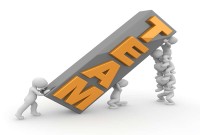- Home
- Business Processes
- Industry Knowledge
- Aerospace Industry
- Automotive Industry
- Banking Domain
- BFSI Industry
- Consumer/ FMCG Industry
- Chemicals Industry
- Engineering & Construction
- Energy Industry
- Education Domain
- Finance Domain
- Hospitality Domain
- Healthcare Industry
- Insurance Domain
- Retail Industry
- Travel and Tourism Domain
- Telecom Industry
- Leadership Skills
- eLearning
- Home
- Leadership Skills
- Leadership & Management
- Types of Power in Leadership
Types of Power in Leadership
Power is the ability to exercise influence or control over others. Leadership involves authority and it is very important for leaders to understand what type of power they're using. The 5 Types of Power in Leadership are Coercive power, expert power, legitimate power, referent power, and reward power. Authority is the right to command and extract obedience from others. It comes from the organization and it allows the leader to use power.
In the functioning of a leader, the ability to guide the action of others is achieved through his or her authority. Carrying out of these decisions is accomplished because of the power of the leader. You will see the relationship between the authority and power of a leader as we go further to understand various types of power.
1. Legitimate Power:
This power comes to the leader when the organization’s authority is accepted. It comes from the rules of the organization. For e.g. parents, teachers, managers, police, etc. have legitimate power only when their authority is accepted in the positions they hold.
2. Expert Power:
This is the power of knowledge and skill of special kinds that is important in getting the job done. A person’s professional competence or knowledge gives him or her expert power. The credibility increases and he or she can lead other persons to trust the judgments and decisions taken by the leader. A leader may not be an expert in all fields, but one can certainly take the help of experts in particular fields as and when required.
3. Charismatic Power:
This is the power of attraction or devotion, the desire of one person to admire another. A subordinate feels a positive attraction towards a leader by identifying oneself, with the leader, or gets influenced by the leader’s attractive power. This power helps the subordinate to understand and value the leader so much that one understands and acts according to the expectations of the boss or the leader. It helps one to act as one’s own boss, and behave in ways one thinks the boss will want.
4. Reward Power:
This power is the present or potential ability to reward for worthy behavior. The superior or the leader has the power to give tangible rewards such as promotion, office space, time off from work, attractive work assignments, and help to the subordinate. Also, psychological rewards like praise, appreciation, approval, and recognition can be given by the leader or the superior to the subordinate. The subordinate has to believe that the leader has access to higher authorities; therefore, the leader can give rewards. This reward power of the leader can also increase the leader’s charismatic and legitimate power.
5. Coercive Power:
This is the ability to threaten or punish. The leader can give tangible punishment like dismissal, demotion, low rating, less satisfying work assignments, etc. Psychological punishments include criticism, avoidance, disapproval or satirical remarks, etc. on the subordinate. The reward power helps to avoid something undesirable. The self-esteem of the subordinate will increase because of reward power. It also decreases because of punishment or coercive power. Even a subordinate may withdraw or break the rules or become hostile. One may not feel attracted to the charismatic power of the leader and at times may ignore the leader’s legitimate power. Having seen the reasons for differences between the authority and power of the leader, you should know the type of leaders as understood on the basis of their authority and power.
Besides the power aspect one should also account for the following:
Formal Leader:
A formal leader is selected by the organization. For example, a manager is a formal leader by virtue of the authority coming from the organization. He or she influences others to help accomplish the goals of the organization or unit. Such leadership lasts over a long period of time.
Informal Leader:
An informal leader is chosen by the group. Thus, all managers are leaders if their authority is accepted, but not all leaders are managers. Informal leadership is leadership without position and may shift from one person to another. It may last for a brief time. Most people are leaders at one time or the other and they can have an influence on others as defined by the concept of leadership itself.
The ideal leader is the one who can combine formal and informal leadership simultaneously within himself or herself.
Related Links
You May Also Like
-
In today's business world, proficiency in management skills is essential for career growth and success. Managerial skills can be defined as attributes or abilities that are essential for every leader and manager to succeed and fulfill specific tasks expected from them by the organization.
-
In its simplest sense, decision-making is the act of choosing between two or more courses of action. Decision making is a key skill in the workplace and is particularly important if you want to be an effective leader. When decisions have to be made, there are several stages that you should go through to reach a practical solution. Understand the meaning and importance of decision making and how to look at it as a process.
-
All the teams are dynamic in nature and they take time to come together, they form, develop, and grow in stages, over a period of time. Teams go through five progressive stages: Forming, Storming, Norming, Performing and Adjourning. In this article, we want to introduce you to these stages of team development and certain strategies that you can use to help the team grow and develop in each of these stages.
-
The development of teams is an ongoing process because the composition of the team may keep on changing. The new members may join and the old members may leave the team. The team members pass through several stages for the development of the team and there has been a lot of research to identify these stages. In this article, we discuss the common theories of team development.
-
Power is the ability to exercise influence or control over others. Leadership involves authority and it is very important for leaders to understand what type of power they're using. The 5 Types of Power in Leadership are Coercive power, expert power, legitimate power, referent power, and reward power. Authority is the right to command and extract obedience from others. It comes from the organization and it allows the leader to use power.
-
Many different types of teams have been identified by social scientists. Managers may encounter the diverse types of challenges while managing different kinds of teams. Challenges associated with Cross-Functional Teams might be different from that of a Geographically Dispersed Team or a Virtual Team. This article explores some common categories and subtypes of teams.
-
Team Foundation in Forming Stage
This is the first stage of team development. This is the stage when the foundation of the team is laid. During the Forming stage, team members have a high dependence on their leader for guidance. Learn the practical strategies you can use during this stage to help your team develop into a highly effective performing team.
-
Process & Stages of Creativity
Creative ideas do not come just like that. There is a process to it. There are a number of techniques of creativity to support the generation of ideas but the widely practiced ones are brainstorming and lateral thinking. Most innovations are not so much the product of sudden insights as they are the result of a conscious process that often goes through multiple stages. The creative process can be divided into four stages of preparation, incubation, evaluation, and implementation.
-
Maslow's hierarchy of needs is a motivational theory that explains that people are motivated by five basic categories of human needs. These needs are physiological, safety, love and belonging, esteem, and self-actualization. There is a little scientific basis for this concept of a hierarchy of needs.
-
Investment Theory of Creativity
Sternberg in the year 2006, proposed the investment and confluence theory focused on understanding creativity. According to the investment theory, creativity requires a confluence of six distinct but interrelated resources known as intellectual abilities, knowledge, styles of thinking, personality, motivation, and environment. It emphasizes that creativity is not about one thing, but about a system of things.
Explore Our Free Training Articles or
Sign Up to Start With Our eLearning Courses

About Us
Learning
© 2023 TechnoFunc, All Rights Reserved










